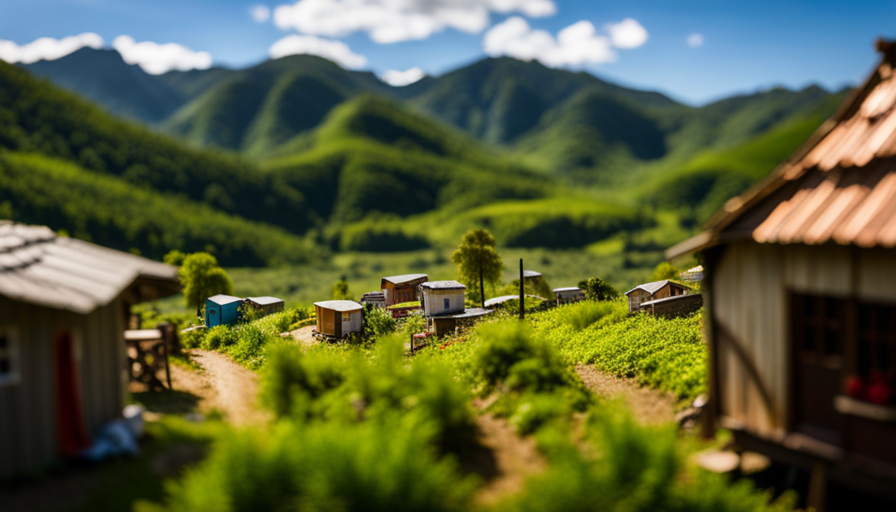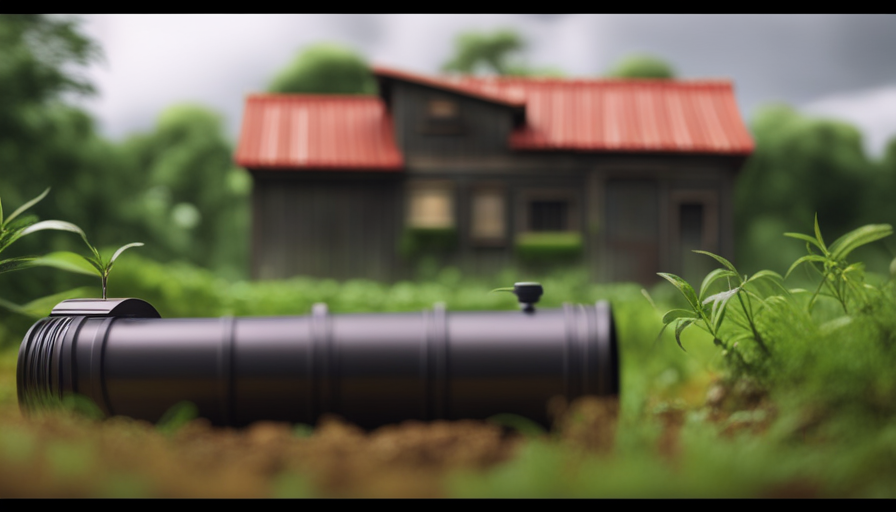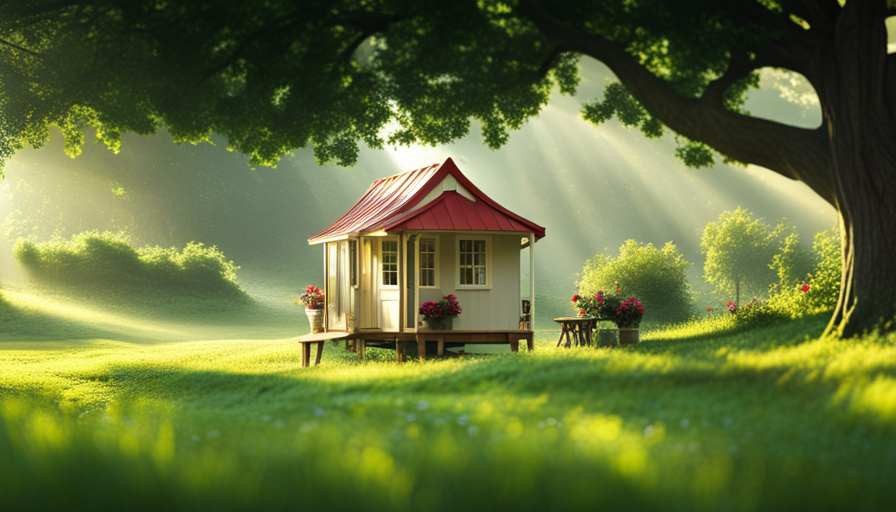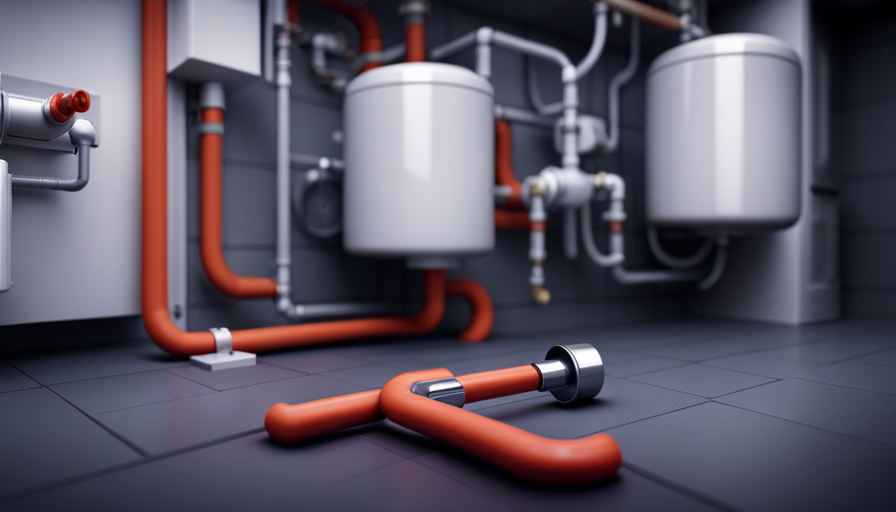Hold on tight, everyone! I’m about to share a groundbreaking idea today that will inspire you to embrace a simpler and more structured life.
Picture this: an 8-foot tiny house that is wide as can be, defying all expectations. Like a diamond in the rough, this innovative design will make you question everything you thought you knew about tiny living.
With a spacious living area, clever layout, and smart storage solutions, this pint-sized wonder maximizes every inch of space, giving you the freedom to breathe and truly enjoy your surroundings. Say goodbye to cramped quarters and hello to a compact size with comfortable living.
Trust me when I say, this 8-foot wide tiny house is the perfect solution for anyone longing to escape the confines of a larger home and embrace a lifestyle of simplicity and efficiency. Get ready to be amazed!
Key Takeaways
- The 8-foot wide tiny house offers a mind-blowing concept for a simpler and more organized life.
- The clever layout and design of the tiny house maximize space and create a spacious living area.
- Smart storage solutions, such as hidden compartments, vertical storage, and built-in shelves, help eliminate clutter and keep everything organized.
- The tiny house features essential amenities cleverly integrated into its compact design, including a dining table that doubles as a workspace and a couch that transforms into a guest bed with hidden storage.
Spacious Living Area
Why don’t you make the living area spacious so you can truly embrace the freedom and simplicity of tiny house living? When designing a foot tiny house, one of the most important considerations is creating an open floorplan that maximizes the available space. By removing unnecessary walls and barriers, the living area feels much larger and more inviting.
This open concept allows for a seamless flow between the different areas of the house, making it feel more like a home rather than a cramped space.
In order to make the most of the limited square footage, incorporating multifunctional furniture is key. By choosing furniture pieces that serve multiple purposes, such as a sofa that can also be converted into a bed or a coffee table with hidden storage compartments, you can optimize the functionality of the living area. This not only saves space but also adds a touch of innovation and creativity to the overall design.
With an open floorplan and multifunctional furniture, the living area of a tiny house becomes a versatile and adaptable space. You can easily transform it from a cozy living room to a dining area or even a home office. The possibilities are endless, and the freedom to customize the space to your needs is truly liberating.
Now, let’s move on to the next section about the clever layout and design of a foot tiny house.
Clever Layout and Design
With its ingenious arrangement and creative design, this cozy abode will leave you marveling at its efficient use of space. The clever organization and creative utilization of every inch make this tiny house feel surprisingly spacious.
The layout is thoughtfully designed to maximize functionality and minimize wasted space. From the moment you step inside, you’ll notice how every nook and cranny has been utilized to its fullest potential.
The open-concept living area seamlessly flows into the kitchen, creating a sense of openness and fluidity. The furniture is strategically placed to create distinct zones within the space, making it feel larger than it actually is. The use of multipurpose furniture, such as a dining table that converts into a workspace, adds to the overall functionality of the space.
In addition to the clever layout, the design elements in this tiny house contribute to its sense of spaciousness. Large windows allow natural light to flood in, making the space feel bright and airy. The use of light colors and reflective surfaces further enhances the illusion of space.
Transitioning into the subsequent section about ‘smart storage solutions,’ you’ll find that this tiny house doesn’t just prioritize clever organization and creative utilization of space; it also offers innovative storage solutions that further maximize the available area.
Smart Storage Solutions
Additionally, this abode showcases ingenious storage solutions that optimize the limited space available. The designers of this tiny house have truly thought of everything when it comes to storage. Here are some of the ways they have cleverly utilized the space:
-
Hidden compartments: The tiny house is full of hidden compartments that are seamlessly integrated into the design. From under the stairs to behind the walls, these hidden storage spaces allow for the maximization of every inch.
-
Multi-functional furniture: Every piece of furniture in this tiny house serves multiple purposes. The dining table doubles as a desk, the sofa transforms into a bed, and even the stairs have built-in drawers for additional storage.
-
Vertical storage: To make the most of the vertical space, the designers have incorporated shelves and cabinets that reach all the way up to the ceiling. This not only provides ample storage for belongings but also adds a sense of height and openness to the space.
-
Creative use of walls: The walls themselves are not just for hanging artwork. They’ve been cleverly designed to have built-in shelves, hooks, and racks, creating even more storage opportunities.
With these innovative storage solutions, every nook and cranny of this tiny house is utilized to its fullest potential. Moving forward, let’s explore all the amenities you need in a space this size.
All the Amenities You Need
Imagine living in a space where all your essential amenities are cleverly integrated, making every inch of the abode functional and efficient.
In a foot tiny house, efficient utilization of space is key to achieving a minimalist lifestyle. Despite its small size, this type of home offers all the amenities you need for a comfortable living experience.
The kitchen, for instance, is designed with innovative storage solutions that maximize every inch of space. Cabinets and drawers are strategically placed to store kitchen tools and appliances, while a compact refrigerator and stove provide the necessary functionality.
The bathroom is also carefully designed to optimize space, featuring a water-efficient toilet, a compact sink, and a shower that neatly folds away when not in use.
Furthermore, the sleeping quarters are ingeniously designed to provide both comfort and functionality. The bed can be easily folded up during the day, revealing a multipurpose space that can be used for work or relaxation. Additionally, cleverly integrated storage compartments are incorporated throughout the tiny house, allowing you to keep your belongings organized and out of sight.
By embracing the minimalist lifestyle and incorporating efficient utilization of space, a foot tiny house offers all the amenities needed for a comfortable living experience. Maximizing every inch of space allows for a seamless transition between different areas of the house, making it feel spacious and open.
Maximizing Every Inch of Space
In this meticulously designed living space, every nook and cranny is transformed into a hidden treasure chest, with storage compartments ingeniously tucked away like secret passageways. Maximizing functionality is the key in this foot tiny house, and every inch of space is utilized to its fullest potential.
The layout is carefully planned to ensure that every area serves multiple purposes. The dining table, for example, doubles as a workspace, with a built-in desk that folds out seamlessly. The couch transforms into a guest bed, complete with hidden storage underneath for extra bedding. Even the stairs leading up to the loft serve as drawers, providing ample space for clothes, shoes, and other belongings.
Creative space utilization is evident throughout the tiny house. The walls are adorned with shelves and hooks, allowing for vertical storage of books, plants, and decorative items. The kitchen features a compact design, with cabinets and drawers cleverly arranged to house all the essentials. A foldable table extends from the counter, creating an additional dining area when needed.
With every aspect of the tiny house carefully considered, saying goodbye to clutter becomes effortless. As you move from one section to another, the innovative storage solutions seamlessly transition, keeping everything neatly organized and easily accessible.
Say Goodbye to Clutter
Bid farewell to chaos and mess as this meticulously designed living space ensures that clutter becomes a thing of the past. In this foot tiny house, every inch is optimized to promote a minimalist lifestyle and efficient organization. The key to achieving such a clutter-free environment lies in the innovative storage solutions that are seamlessly integrated into the design.
The tiny house boasts cleverly hidden compartments and multi-purpose furniture, allowing for the maximization of space without sacrificing functionality. From built-in cabinets that double as seating to foldable tables that can be tucked away when not in use, every element serves a purpose in keeping the living area organized and clutter-free.
Efficient organization is further enhanced by the use of vertical storage solutions. Shelves and hooks are strategically placed on walls and ceilings, providing ample space to store belongings while keeping them easily accessible. Utilizing the vertical space not only frees up floor area but also adds a visually appealing element to the overall design.
With a place for everything and everything in its place, this foot tiny house introduces a simpler, more organized life. Say goodbye to the stress of searching for misplaced items or feeling overwhelmed by the accumulation of unnecessary belongings. Embracing a minimalist lifestyle has never been easier or more stylish. Hello to a simpler, more organized life, where everything has its designated spot and clutter is a thing of the past.
Hello to a Simpler, More Organized Life
As I bid farewell to clutter and embrace a simpler, more organized life, I find myself drawn to the concept of sustainable living and a minimalist lifestyle. It’s incredible how freeing it feels to let go of unnecessary possessions and focus on what truly matters.
In my quest for a more intentional way of living, I discovered the foot tiny house movement, which perfectly aligns with my values. Living in a tiny house not only reduces my ecological footprint but also allows me to prioritize experiences over material possessions. The compact size of a tiny house encourages me to be creative with the use of space, resulting in a home that is both functional and aesthetically pleasing.
As I envision my future in a tiny house, I can’t help but get excited about the possibilities it offers. I imagine myself waking up to the sound of birds chirping outside my window, surrounded by nature and the simple beauty of sustainable living. I envision a cozy reading nook, a kitchenette that inspires me to cook wholesome meals, and a serene bedroom that promotes restful sleep.
Transitioning into the next section about ‘compact size with comfortable living,’ I eagerly explore how a tiny house can offer all the comfort and amenities of a traditional home, despite its small footprint.
Compact Size with Comfortable Living
Embracing a minimalist lifestyle opens up a world of possibilities for creating a cozy and comfortable living space in a compact home. With a compact design and efficient use of space, a tiny house can offer all the comforts of a larger home without sacrificing functionality.
Every square foot is carefully considered to maximize its potential, resulting in a truly innovative living experience. In a tiny house, every nook and cranny is utilized to its fullest extent. From multifunctional furniture that serves dual purposes, such as a bed that can be converted into a dining table or storage space hidden beneath the stairs, to clever storage solutions like built-in shelving and wall-mounted organizers, every inch is optimized for efficiency. The compact design ensures that everything is within easy reach, eliminating the need for excessive walking or wasted space.
Despite its small size, a tiny house can still provide a comfortable living environment. Thoughtful design choices, such as large windows to maximize natural light and the use of light-colored materials to create an illusion of spaciousness, contribute to a sense of openness and airiness. Additionally, innovative solutions like loft bedrooms or fold-out desks allow for flexible living arrangements, adapting to the changing needs of the homeowner.
Transitioning into the subsequent section about ‘innovative tiny house design,’ it becomes clear that the compact size of a tiny house does not limit the possibilities for innovative and creative design choices.
Innovative Tiny House Design
After exploring the benefits of a compact size with comfortable living in a tiny house, it’s time to delve into the innovative design that makes these small spaces so remarkable.
As I stand inside my own tiny house, I’m surrounded by an ingenious use of sustainable materials and a design that maximizes every inch of space. The walls are constructed from reclaimed wood, not only adding a rustic charm but also reducing the environmental impact of my home. The windows are strategically placed to allow ample natural light to flood in, creating a bright and airy atmosphere.
One of the most impressive features of this tiny house is its off-grid capability. Utilizing solar panels and a rainwater collection system, I’m able to live completely self-sufficiently. This not only reduces my carbon footprint but also allows me to experience the freedom of living off the grid.
As I look around, I’m in awe of how this innovative design has transformed this small space into a sustainable haven. Every element has been carefully considered to ensure functionality and comfort, making it the perfect solution for cramped spaces.
The Perfect Solution for Cramped Spaces
With its clever use of sustainable materials and innovative design, this small space offers the ideal solution for those who are limited on room. In today’s fast-paced world, many people are opting for a minimalist lifestyle. This tiny house design embraces the benefits of minimalism by maximizing the use of space and resources.
One of the key features of this tiny house is its efficient use of resources. Every inch of the space is carefully planned and utilized to its fullest potential. From the compact kitchenette to the multifunctional furniture, every element serves a purpose. This not only reduces waste but also minimizes the need for excess belongings.
Another benefit of this tiny house design is the use of sustainable materials. The walls are constructed from recycled materials, while the flooring is made from renewable resources. The roof is equipped with solar panels, providing an eco-friendly source of energy. Additionally, the house incorporates natural lighting and ventilation systems, reducing the need for artificial lighting and air conditioning.
This innovative tiny house design is the perfect solution for cramped spaces. By embracing minimalism and efficient use of resources, it offers a sustainable and practical living option. Whether you’re looking to downsize or simply want to live a more environmentally conscious lifestyle, this tiny house provides a comfortable and stylish solution.
Frequently Asked Questions
How much does the 8-foot tiny house cost?
The cost of an 8-foot tiny house can vary depending on factors such as materials, design, and location. However, a cost comparison can help determine the best financing options available for this innovative and compact living solution.
Can the 8-foot tiny house be customized to fit specific needs?
Yes, the 8-foot tiny house can be customized to fit specific needs. With a range of customization options, including layout and storage solutions, space utilization is maximized to create a personalized and functional living space.
What are the maintenance requirements for the 8-foot tiny house?
Maintaining the 8-foot tiny house requires regular upkeep to ensure its functionality and longevity. Some potential challenges include limited space for storage and the need for efficient organization. Attention to detail and dedication are key.
Is the 8-foot tiny house suitable for year-round living?
Living in an 8-foot tiny house year-round has its challenges. The insulation is crucial for maintaining comfort in different climates. Pros include lower costs and a simpler lifestyle, but cons include limited space and potential difficulties in extreme weather conditions.
Can the 8-foot tiny house be transported easily to different locations?
Yes, the 8-foot tiny house can be easily transported to different locations. Its compact size allows for convenient transportation, and its lightweight construction provides advantages in terms of flexibility and mobility.
Conclusion
Well, well, well. Who would’ve thought that an 8-foot tiny house could offer such a luxurious and spacious living experience? It’s like living in a mansion, but on a smaller scale.
The clever layout and design of this tiny house will blow your mind. And don’t even get me started on the smart storage solutions. You’ll have more space for your belongings than you ever thought possible.
Say goodbye to clutter and hello to a simpler, more organized life. Trust me, this innovative tiny house design is the perfect solution for cramped spaces.
Get ready to be amazed!
Hi, I’m Emma. I’m the Editor in Chief of Tiny House 43, a blog all about tiny houses. While tree houses are often associated with childhood, they can be the perfect adult retreat. They offer a cozy space to relax and unwind, surrounded by nature. And since they’re typically built on stilts or raised platforms, they offer stunning views that traditional homes simply can’t match. If you’re looking for a unique and romantic getaway, a tree house tiny house might just be the perfect option.










